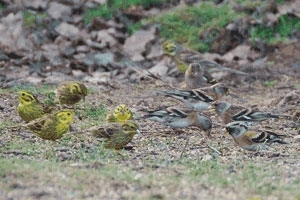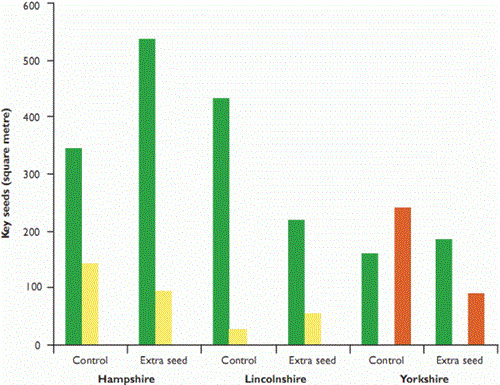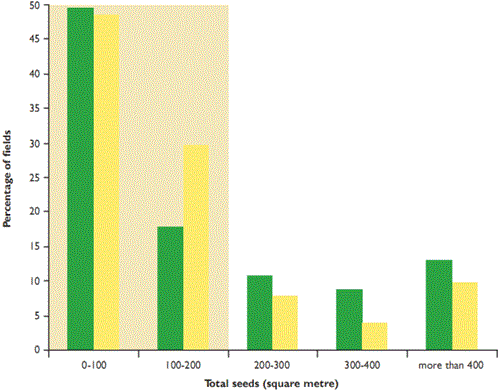 Weed seeds are one of the main foods for farmland birds and small mammals in winter. Rotational set-aside created a lot of winter stubbles, and with the loss of set-aside, there is debate over how best to replace it. There is evidence that a shortage of seeds in winter contributes to the decline of farmland birds.
Weed seeds are one of the main foods for farmland birds and small mammals in winter. Rotational set-aside created a lot of winter stubbles, and with the loss of set-aside, there is debate over how best to replace it. There is evidence that a shortage of seeds in winter contributes to the decline of farmland birds.
We measured the abundance of weed seeds on the soil surface through the winter on 40 fields on each of three farms in Hampshire, Lincolnshire and Yorkshire. On half of these fields, we broadcast 36 kilogrammes per hectare of bird seed three times through the winter to determine the extent to which seed supplies could be limiting farmland birds. We measured seed abundance three times over the winter at the field edge, where small mammals and hedgerow birds feed and also mid-field, where buntings, finches and sparrows prefer to forage.
Overall, 80% of the seeds were of six species: chickweed, common orache, corn poppy, fat hen, field pansy and knotgrass. Seed densities fell (they were either eaten or moved deeper into the soil) by an average of 73% and 87% on two farms between early and mid-winter (see Figure 1). These two farms had a large number of stubbles so seeds were accessible to a lot of birds. Across all sites, we found that by January the density of the seeds from broad-leaved weeds at the field edge and mid-field was well below the levels (250-500 seeds per square metre) considered necessary to attract and hold farmland birds (see Figure 2); in fact 30% of all stubbles had insufficient seed. Modern herbicide programmes are highly effective and few weeds survive to produce seed. Seed densities were similar at the edge and mid-field except at one site where conservation headlands had been used.
Figure 1: Mean density of seeds important for farmland birds (key seeds) in 40 control blocks and those receiving extra seed for the three study sites

The extra seed that was applied was rapidly depleted by large flocks of birds soon after the seed was broadcast. These birds also removed the larger weed seeds of common orache, fat hen, field pansy and knotgrass (see Figure 1).
Herbicides deplete the seedbank and, consequently, most stubbles now provide poor foraging for farmland birds and consequently the loss of set-aside may not have such an impact on farmland as anticipated. Thus, seed may be more efficiently provided by growing wild bird seed crops rather than reducing herbicide inputs or leaving more stubbles.
The Trust would like to thank the Pesticide Safety Directorate for funding this research.
Figure 2: Mean density of seeds important for farmland birds (key seeds) in 40 control blocks and those receiving extra seed for the three study sites
